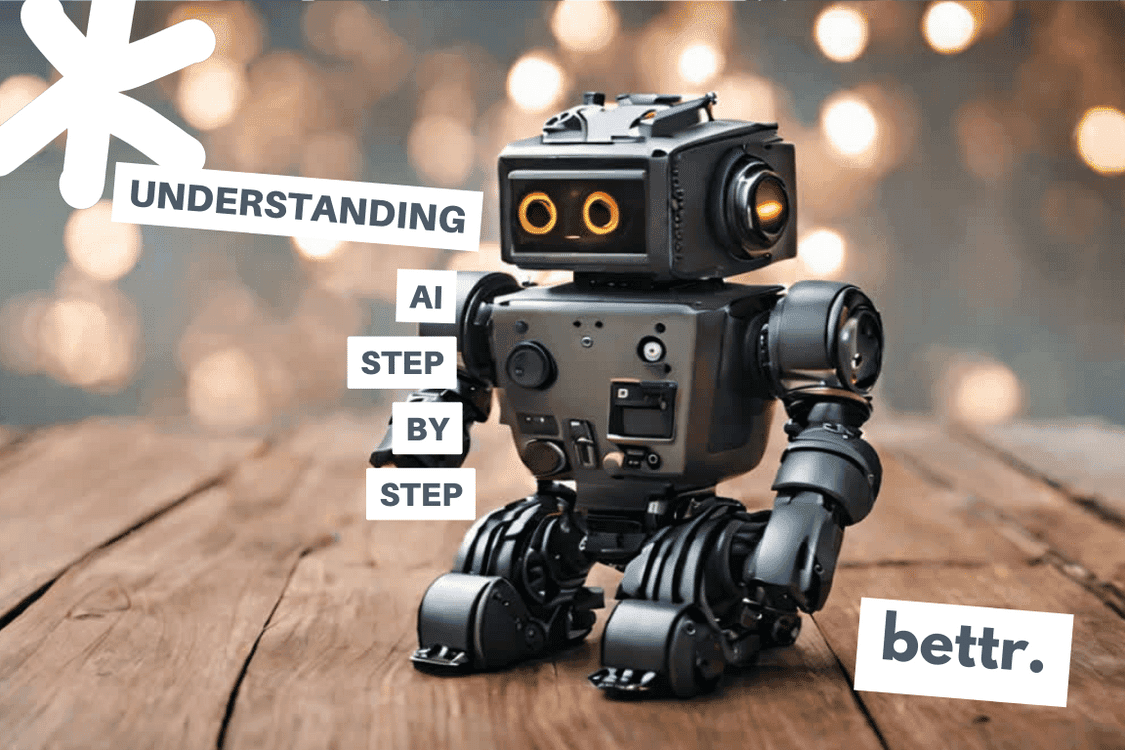Understanding AI: A Step-by-Step Guide
Understanding AI: A Step-by-Step Guide
Feb 21, 2024
Understanding AI: A Step-by-Step Guide
I. What is AI?
Definition: Artificial Intelligence (AI) refers to the ability of machines to mimic human cognitive functions like learning and problem-solving.
History: AI research has existed for decades, with significant advancements in recent years due to increased computing power and data availability.
Types: AI encompasses various approaches, from simple rule-based systems to complex machine learning algorithms.
Step 1: Diving Deeper into AI - Capabilities, Limitations, and Considerations
What is AI?
Artificial Intelligence (AI) encompasses a broad range of approaches to create intelligent machines capable of mimicking human cognitive functions. It's NOT about creating sentient or conscious machines, but rather about enabling machines to learn, reason, adapt, and solve problems in ways that were previously thought to be exclusively human.
What Can AI Do?
Automate tasks: From simple data entry to complex robotic surgery, AI can automate repetitive and often tedious tasks, freeing humans for more creative and strategic work.
Analyze vast amounts of data: AI excels at processing and analyzing large datasets, uncovering patterns and insights that humans might miss, leading to better decision-making in various fields.
Learn and adapt: Some AI systems can learn from their experiences and adapt their behavior to new situations, improving over time without explicit programming.
Recognize patterns and make predictions: AI algorithms can identify patterns in data and use them to make predictions about future events, such as customer churn, financial market trends, or weather patterns.
Generate creative content: AI can generate text, images, and even music, finding applications in design, marketing, and entertainment.
What Can't AI Do?
Replicate true human emotions or empathy: While AI can analyze and respond to emotions, it lacks the depth and complexity of human emotional experience.
Possess true creativity or understanding: AI can generate creative outputs based on existing data, but it cannot truly innovate or understand the meaning of its creations.
Be entirely self-aware or conscious: Current AI lacks the self-awareness and consciousness present in humans, and ethical considerations are crucial when discussing advanced AI capabilities.
Solve all problems perfectly: AI systems are still prone to errors and biases, and their performance depends on the quality of data and algorithms used.
Benefits and Drawbacks:
Benefits:
Increased efficiency and productivity
Improved decision-making and problem-solving
Innovation and new discoveries in various fields
Personalized experiences and services
Automation of dangerous or tedious tasks
Drawbacks:
Job displacement and unemployment concerns
Potential for bias and discrimination if algorithms are not carefully designed
Ethical concerns about privacy, surveillance, and control
Misuse of AI for malicious purposes
Overdependence on AI and loss of human skills
II. How is AI used today?
Everyday applications: From virtual assistants like Siri to personalized recommendations on Netflix, AI is woven into our daily lives.
Industries: AI is transforming fields like healthcare, finance, manufacturing, and transportation, automating tasks, optimizing processes, and driving innovation.
Scientific discoveries: AI is used in drug discovery, climate modeling, and other research areas to analyze complex data and make predictions.
III. AI vs. Machine Learning:
AI: A broad term encompassing various approaches to intelligent machines.
Machine Learning: A specific type of AI where algorithms learn from data without explicit programming, allowing for adaptation and improvement over time.
IV. AI for Non-Coders and Non-Tech People:
Non-coding tools: Many AI tools are designed for ease of use, with drag-and-drop interfaces and pre-built models.
Productivity benefits: AI can automate repetitive tasks, analyze data for insights, and generate creative content, freeing up time for more strategic work.
Increased capacity: By automating repetitive tasks and providing data-driven insights, AI allows individuals to focus on higher-level thinking and problem-solving, leading to greater efficiency and effectiveness.
V. AI Step-by-Step:
Define the problem: Identify the task or challenge you want AI to address.
Gather data: Collect relevant data to train the AI model.
Choose an AI model: Select an appropriate AI model based on the problem and data.
Train the model: Feed the data to the model and allow it to learn and improve.
Evaluate and refine: Test the model's performance and make adjustments as needed.
Deploy and use: Integrate the AI model into your workflow or application.
Step II: Under the Hood of AI Assistants - Siri & Alexa
Siri and Alexa, our ubiquitous voice assistants, rely on a blend of AI technologies to understand our requests and respond intelligently. Let's delve into the magic behind them:
Technology Breakdown:
Natural Language Processing (NLP): This core component allows them to understand the meaning of our spoken words. NLP utilizes techniques like speech recognition, text analysis, and grammar rules to extract intent and context from our queries.
Machine Learning (ML): This subfield of AI empowers them to learn and improve over time. By analyzing massive datasets of user interactions and responses, they continuously refine their understanding of language and personalize their responses based on individual preferences and past interactions.
Automatic Speech Recognition (ASR): This technology converts our spoken words into text the AI can understand. Advanced ASR models can handle variations in accents, background noise, and even slang.
Text-to-Speech (TTS): Once the AI comprehends our request, it uses TTS to generate a natural-sounding response. This involves advanced algorithms that synthesize speech based on linguistic and phonetic rules.
Knowledge Graphs and Information Retrieval: These systems store and access vast amounts of information, allowing the AI to answer questions and complete tasks. Siri and Alexa tap into various sources like web databases, knowledge bases, and connected smart devices to provide relevant information.
Future Possibilities:
Enhanced Contextual Understanding: AI assistants are moving beyond keyword matching, incorporating context and intent to provide more personalized and helpful responses. Imagine seamlessly scheduling appointments, booking tickets, or controlling smart home devices with natural, nuanced conversations.
Multimodality: AI assistants are likely to integrate with other sensory inputs like facial expressions and gestures, leading to richer and more natural interactions. Imagine having a conversation where the AI understands your frustration or excitement through your tone and body language.
Proactive Assistance: Moving beyond reactive responses, AI assistants could anticipate your needs and proactively offer suggestions based on your habits and routines. Imagine your assistant reminding you to buy groceries when you're running low or suggesting a new restaurant based on your preferences.
Domain-Specific Expertise: Specialized AI assistants could cater to specific needs in domains like healthcare, finance, or education. Imagine interacting with a medical assistant that understands your medical history and answers complex questions about your health.
However, ethical considerations remain paramount:
Privacy and data security: Ensuring user privacy and protecting sensitive data is crucial as AI assistants become more integrated into our lives.
Algorithmic bias: Mitigating biases in training data and algorithms is essential to prevent discriminatory or unfair outcomes.
Transparency and explainability: Users deserve to understand how AI assistants arrive at their decisions and responses, fostering trust and responsible use.
As AI technology continues to evolve, the capabilities of Siri and Alexa, and their future counterparts, will likely far exceed our current imagination. It's crucial to stay informed, engage in responsible development, and ensure that AI assistants serve as tools for good, empowering and enriching our lives.
Step 3a: Choosing the Right AI Model for Your Needs
Types of AI Models:
Supervised Learning: These models learn from labeled data, where each data point has a corresponding desired output. Examples include:
Linear Regression: Predicts continuous values like sales based on other factors.
Logistic Regression: Classifies data into categories like spam or not spam.
Decision Trees: Make predictions based on a series of rules.
Deep Neural Networks: Complex models capable of handling large amounts of data and complex tasks.
Unsupervised Learning: These models analyze unlabeled data to identify patterns and structures. Examples include:
Clustering: Groups similar data points together.
Dimensionality Reduction: Simplifies complex data for easier analysis.
Anomaly Detection: Identifies unusual data points.
Reinforcement Learning: These models learn through trial and error, interacting with an environment and receiving rewards for desired behavior. Examples include:
Game-playing AI: Learns to play games like chess by exploring different strategies.
Robot Control: Learns to perform tasks like walking or grasping objects.
Training AI Models:
Each model type has its own training process, but some common steps include:
Data Preprocessing: Cleaning and formatting the data for the model.
Model Selection: Choosing the right model based on the problem and data.
Hyperparameter Tuning: Adjusting specific settings within the model to improve performance.
Training: Feeding the data to the model and iteratively improving its accuracy.
Choosing the Right Model:
Several factors influence your choice:
Problem type: Is it classification, prediction, clustering, etc.?
Data type: Text, images, numbers, etc.?
Data size: How much data do you have?
Computational resources: How much processing power can you afford?
Interpretability: Do you need to understand the model's reasoning?
Additional Tips:
Start with simpler models and progress to more complex ones as needed.
Experiment with different models on a small subset of your data before committing to a specific one.
Consult experts or online resources for specific guidance on your use case.
Remember, choosing the right AI model is crucial for success. By understanding the available types, training methods, and selection criteria, you can leverage the power of AI to effectively solve your problem.
VI. Tools & Benefits:
Natural Language Processing (NLP): Analyze text data for sentiment, intent, and meaning (e.g., chatbots, translation tools).
Computer Vision: Extract information from images and videos (e.g., facial recognition, object detection).
Predictive Analytics: Forecast future trends and outcomes based on historical data (e.g., risk assessment, demand forecasting).
Generative AI: Create new content, like text, images, or music, based on existing data (e.g., design ideas, marketing copy).
Step IV: AI for Business Productivity - Time-Saving Tools & Strategies
The busy world of business can benefit greatly from AI's ability to automate tasks, analyze data, and provide insights. Here's how you can leverage AI for immediate time-saving and productivity gains:
1. Automate Repetitive Tasks:
Email Management: Tools like Grammarly and Boomerang automate mundane tasks like scheduling emails, checking grammar, and filtering spam, freeing up your time for more strategic communication.
Data Entry & Extraction: AI-powered tools like UiPath and Zapier can automatically extract data from various sources and populate spreadsheets or databases, eliminating manual data entry errors and saving hours.
Social Media Management: Platforms like Hootsuite and Buffer automate scheduling and publishing social media posts, allowing you to manage multiple accounts efficiently and save time on content creation.
2. Enhance Data Analysis & Decision-Making:
Sales & Marketing Analytics: Tools like Salesforce Einstein and HubSpot AI analyze customer data to identify trends, predict churn, and personalize marketing campaigns, leading to better sales conversions and ROI.
Financial Forecasting: AI-powered platforms like Aylien and Sentifi analyze financial data and news articles to predict market trends and identify risks, enabling better investment decisions.
Customer Service Chatbots: AI-powered chatbots can answer basic customer questions, freeing up human agents for complex inquiries and improving overall customer satisfaction.
3. Generate Creative Content & Optimize Workflow:
Content Creation Tools: Platforms like Jasper.ai and ShortlyAI use AI to generate marketing copy, blog posts, and even social media captions, saving time and boosting content creation efficiency.
Project Management Platforms: Tools like Asana and Trello integrate AI features like smart scheduling, task prioritization, and automated reminders, streamlining project workflows and improving team collaboration.
Document Summarization & Translation: AI-powered tools like DocuSign Insight and DeepL can summarize lengthy documents and translate them instantly, saving you time and effort while processing information.
Remember:
Start small and experiment: Choose a specific task or workflow to automate first and gradually integrate AI into your routine.
Focus on user-friendly tools: Many AI tools offer intuitive interfaces and require minimal technical expertise.
Prioritize data quality: Ensure your data is accurate and relevant for AI models to function effectively.
Embrace ethical considerations: Use AI responsibly and transparently, avoiding bias and ensuring fair outcomes.
By utilizing these AI-powered tools and strategies, you can free up valuable time, make data-driven decisions, and enhance your overall business productivity. Remember, AI is a powerful tool, and with thoughtful implementation, it can be a game-changer for your success.
Remember: AI is a powerful tool, but it's crucial to use it responsibly and ethically. With careful planning and ethical considerations, AI can be a valuable asset in enhancing your personal and professional life.





